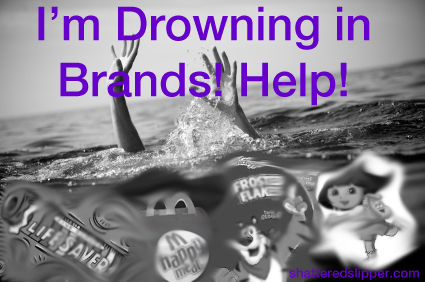In today’s society we are infiltrated with brands through advertisements that play Houdini mind tricks on us, which at some point (probably right away) form our opinions of what clothing we wear, food we eat, toys we buy, etc. But if you’re a kid/teenager, you are drowning in it and don’t have a chance to come up for air! Someone toss the kids Life Savers (see what I did there?)
 On average an American teenager spends 31 hours a week watching TV, 17 hours listening to music, and 10 hours online. (LoveSocial with MissRepresentation.org) And well marketers are no dummies, they hit those groups full-force straight in the ‘noggin.
On average an American teenager spends 31 hours a week watching TV, 17 hours listening to music, and 10 hours online. (LoveSocial with MissRepresentation.org) And well marketers are no dummies, they hit those groups full-force straight in the ‘noggin.
In college I watched a documentary called Consuming Kids. You should watch it, highly fascinating and scary all at the same time! AH. My knowledge of this documentary resurfaced when Anna Lappe a concerned mother and food mythbuster honed in on the food industry in particular and the obsession that kids develop.
“The food industry says themselves that they spend $2 billion every year in marketing directly to children and teenagers,” said Lappe in her TEDxTalk. “When you think about it in the context that diet related illnesses among young people are on the rise, and we think about this omnipresent marketing I think it isn’t an exaggeration that is has become down right dangerous.”
Yep, Lappe knows what’s up. When I (hopefully) become a parent I can only shield my children so much because, like the Lappe and Consuming Kids noted, commercialization is burying children under a pile of consumer messages. It’s inevitable they will receive that commercial stimulus in schools, day care, or at slumber parties, EV.ERY.WHERE. It’s not ideal to guard children from social situations because that doesn’t help children develop either. It’s clear that parenting in the 21st Century is more difficult than ever!
This ideal paralleled with that of Matthew McAllister who explains in his chapter “Just How Commercialized Is Children’s Culture?” in 20 Questions about Youth and Media that the basis of all commercial logic is sales whether direct to kids or indirect to kids’ parents. The child communication and psychology experts in the Consuming Kids were frustrated by this single-minded approach to marketing, but the fact is the marketers are succeeding in creating a “cradle to grave” brand loyalty.
Part of the reason why these creepy clever marketers are successful is because they have studied how children relate to media and learned to market more effectively during the 1980s when the FTC and FCC were stripped of their authority to regulate children advertisements. Ever since then, marketing agencies have been working hard to drop the opacity on the line between what’s culture and what’s commercial within children’s media.
Aggressive ads, growth of mega-media corporations and proliferation of new media are to blame for this overlap. Yep, I’m calling it! Ads are forced to be more aggressive because of the new technologies that allow viewers to skip traditional ads. Note: the magical world of DVR and TiVo. The major networks own child-based networks creating a conglomerate of commercial buying power. Now, with the not-so-new new media like cell phones and the Internet, the advertising game has changed. What Mr. McAllister carefully noted was “accelerated movement in all of culture, not just kids’.” Consuming Kids focused primarily on the acceleration of kid culture. I’m sensing a pattern here. Kids are on the fast track of life missing out on their childhood years because of the “360 degree immersive marketing,” influencing them to dress or behave like they are adults—and the primary reason I started this blog. I care about how fast kids, mainly girls are growing up at this lightening speed. Shabooom, see ya childhood. It’s out with the My Little Pony generation and in with the go-go gadgets of my favorite fruit brand via the iTouch/Phone/Pad/Pod. This constant access I have dubbed the “24/7-you-can’t-get-away-from-ads-even-if-you-wanted-to-suckahs-approach.” You’re welcome marketers of the world, put that in your next PowerPoint.
The primary problem: Deregulation. There is zero policy in the US that aims to prevent these types of ads. Go figure probably because corporation own the US government but that’s a whole ‘nother blog.

Pingback: Moral Panic Mode: Journalists/Documentarians | The Shattered Glass Slipper
Pingback: Pink…Not Always a Girl Thing | The Shattered Glass Slipper